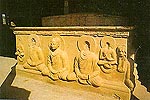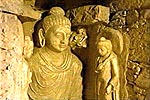 At Taxila, you can see the great Buddha.
His eyes will gaze upon you till you find yourself gripped by the
feeling of awe. Other people whom you can meet at Taxila are, Alexander
of Macedonia, Asoka the famous Buddhist king and Kanishka. You'll find
their imprints all over the place.
At Taxila, you can see the great Buddha.
His eyes will gaze upon you till you find yourself gripped by the
feeling of awe. Other people whom you can meet at Taxila are, Alexander
of Macedonia, Asoka the famous Buddhist king and Kanishka. You'll find
their imprints all over the place.
In 327 B.C. Alexander conquered Taxila which was the Achaemenian Empire. Later it came under Mauryan dynasty and reached a great level of development under the rule of great Asoka.
The next step in Taxila's history was the indo-Greek descendents of the
Alexander warriors. The final period is called The Gandhara period. The
great Kushan Dynasty was then established in 50 A.D, and within these
200 years Taxila became the most renowned center for philosophy, art and
learning.  Taxila is the greatest attraction for
the pilgrims and tourists coming from China and Greece. The final period
of Taxila is in the fifth century A.D. when white Huns snuffed out the
most successful and the greatest Gandhara civilization of last several
centuries.
Taxila is the greatest attraction for
the pilgrims and tourists coming from China and Greece. The final period
of Taxila is in the fifth century A.D. when white Huns snuffed out the
most successful and the greatest Gandhara civilization of last several
centuries.
Exploring Taxila is a multi-dimensional experience. The richness and
variety of the famed Gandhara sculpture is bound to attract your
attention. There are many images of Buddha, in stone and stucco and
numerous panels depicting all the important stages of the great Sage's
life. One may also find sculptures of the world's most impressive men of
peace. Each carved bit of sculpture shows extravagant beauty and
mesmerizing artistery, from colossal to miniature there are literally
thousands of such master peices in this collection. To find the
difference between the Greek-Roman counterparts and the Gandhara
masterpieces will be of great challenge to you. To welcome you there,
are stone men and women who will receive you with open arms in Taxila.
 Then there are the three distinct
cities, which are nicely preserved. With your imagination sided by the
carved people who inhabit these cities, you will have little difficulty
in picturing crowds on the well-laid-out streets, families in spacious
houses, priests in the towering stupas and royalty in great palaces.
Then there are the three distinct
cities, which are nicely preserved. With your imagination sided by the
carved people who inhabit these cities, you will have little difficulty
in picturing crowds on the well-laid-out streets, families in spacious
houses, priests in the towering stupas and royalty in great palaces.
The earliest city of these, is known as Bhir Mound. Which was established somewhere in the sixth century B.C, whose irregular streets, cramped houses and mediocre public buildings indicate its primitive origins. Then comes the Sirkap city which is on the opposite side of Tamara stream, and was built somewhere around the 2nd century B.C. You will find a marked difference between these cities as this city was well planned.
As you stroll down its streets you can call at the houses of the affluent and go slumming, as it were, in the more crowded sections where dwelt the common man of the dim and misty past. Note the fortification of wall, the long, straight and impressive main street, the Royal palace, an Apsidal Temple and the shrine of the double headed eagle. Sirsukh the most modern city of them was built by Kushan kings in the first century A.D. It is'nt fully excavated as yet but is clearly, a well-fortified and well-laid-out city. This city is patterned after the Central Asian cities, and is complete with suburbs.
 In addition to these cities, there are
many monasteries and stupas which have been excavated all along the
Taxila valley. Dharmarajika stupa, which is 2 miles from Taxila museum
is a must see stupa. It comprises mainly of buildings, a monastery area
where the monk lived and a series of small chapels. Wealth of gold,
silver coins, gems, jewelry and other antiques were discovered at
Dharmarajika.
In addition to these cities, there are
many monasteries and stupas which have been excavated all along the
Taxila valley. Dharmarajika stupa, which is 2 miles from Taxila museum
is a must see stupa. It comprises mainly of buildings, a monastery area
where the monk lived and a series of small chapels. Wealth of gold,
silver coins, gems, jewelry and other antiques were discovered at
Dharmarajika.
Jaulian, another marvelous complex of chapels, stupas, quadrangles, and a monastery with assembly hall, store rooms, refectory, kitchen and bathrooms. At five small stupas you will see some beautiful stucco, the relives of Buddha and Bodhisattvas and supported by rows of stone elephants and lions.
Two miles west of Jaulian is another well-preserved monastery at Mohra Moradu. In one of the monk's cells here was found a stupa with almost all of the details intact. At Jandial, a mile-and-a-half from Sirsukh, is an imageless temple in the classic Greek style, with sandstone columns and cornices.
 Attraction for climbers is Glen of Giri,
which is about three-and-half miles from Dharmarajika stupa. Atop the
highest peak of the range of hills are two stupas and a fortress built
in a cleft near a spring of pure, sweet water. The stucco decorations of
the stupas are well worth the climb.
Attraction for climbers is Glen of Giri,
which is about three-and-half miles from Dharmarajika stupa. Atop the
highest peak of the range of hills are two stupas and a fortress built
in a cleft near a spring of pure, sweet water. The stucco decorations of
the stupas are well worth the climb.
A visit to Taxila is worth spending your money. The men 3000 years ago knew what they were doing when they chose Taxila to built there cities. To feel the enchanting aura and to understand their full importance you'll have to pay a visit to Taxila. It will take you to an inspiring journey of ancient civilization.


